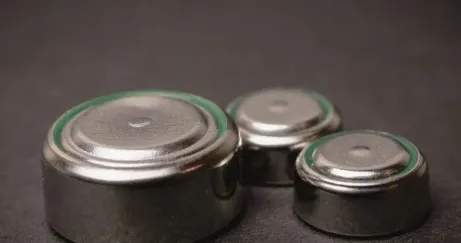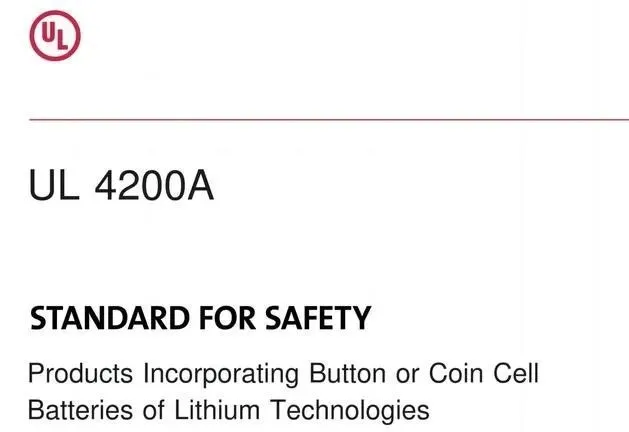
What is UL 4200A 2023 Standard?
Button batteries are used in many consumer products, such as remote controls and quartz watches. According to relevant data, every 75 minutes, a child receives treatment for battery-related injuries in the emergency room, with swallowing being the main cause of these visits, and 85% of cases involving button batteries. If a child accidentally swallows a button battery, it may become lodged in the throat, triggering an immediate electric current upon contact with saliva, leading to cheMICal reactions. In severe cases, it can even cause burns to the esophagus, trachea, and aorta. These dangerous incidents may occur in as little as two hours, and even if the battery is removed, the severity of burns may continue to worsen. Additionally, depleted batteries can still carry enough charge to cause serious injury and death.

In September 2023, the U.S. Consumer Product Safety Commission (CPSC) voted to approve UL 4200a-2023 as a mandatory consumer product safety rULe for products containing button batteries, aiming to REDuce the ingestion hazards for children aged 6 and under.
Note: Any product containing button batteries exported to the United States must comply with the requirements of UL 4200A, regardless of whether the button batteries are replaceable or rechargeable.
Amazon Policy on Consumer Products with Button Batteries or Coin Batteries
Amazon requires that all consumer products containing button batteries or coin batteries falling within the scope of 16 cfr part 1263 be tested and comply with the following regulations, standards, and requirements.
Hence, sellers need to pay extra attention to product safety when selling such items, as non-compliant products will be removed from Amazon's platform.
Consumer Products Containing Button Batteries or Coin Batteries Standards
- 16 CFR Part 1263: Safety Standard for Button Batteries or Coin Batteries and Consumer Products Containing Such Batteries
- ANSI/UL 4200: Safety Standard for Products Containing Button Batteries or Coin Batteries

Structure Requirements of UL 4200A
1. For products with "batteries that allow users to move or replace":
- The IEC 61032 No. 11 test probe must not contact the battery. Shells that can be opened without tools or with fewer than two independent consecutive actions should be opened during inspection for evaluation.
- Products need to be designed to prevent children from moving the battery, such as requiring tools (e.g., screwdrivers, coins) to open the battery compartment, with a minimum rotation angle of 0.5Nm and 90 degrees, or fasteners must engage at least two full threads; or, if opened by hand, it should require at least two independent and simultaneous actions to open the cover or door of the battery compartment.
- If the cover or door of the battery compartment is secured by screws or similar fasteners, the fasteners must be limited to the cover or door, such as screws that cannot be loosened.
2. For products with "batteries that do not allow users to move or replace":
- They must effectively prevent users or children from removing the batteries, and the products must be designed as follows:
- By enclosing the batteries within the shell or similar means.
- Or by welding, riveting, or similar methods to completely fix the batteries.


Testing Requirements
- Preprocessing
- Drop test
- Impact test
- Crush test
- Torque test
- Pull test
- Compression test
- Firmness test (for batteries that do not allow users to move or replace)
Warning Labels (on the Product Itself)
1. If the product has sufficient space, use the following label (Figure 7C.1):
2. If the product does not have enough space, you can use the label (Figure 7C.2), but the meaning of this symbol should be explained in the product manual or other printed materials or tags accompanying the product.
3. If the product does not have enough space for either label (Figure 7C.1 or Figure 7C.2), then the packaging of the product should comply with the packaging's warning label requirements, or include the complete packaging warning label requirements in tag form.
Warning Labels (on the Packaging)
Note: Warning labels on the packaging are necessary regardless of whether there is space on the product.
1. If the main space of the packaging is sufficient, use Figure 7B.1 or Figure 7B.2.
2. If the main space of the packaging is not sufficient, you can use Figure 7B.3 on the main space of the packaging and Figure 7B.4 on the secondary space of the packaging. Note that using only one is insufficient.
Considerations for Warning Labels
- When there are multiple colors on the label, ensure that the colors match specific colors on the above warning labels.
- The icon size should be at least 7mm wide and 9mm high; the icon in Figure 7B.2 should be at least 8mm in diameter.
- The markings must use the official language of the country where the product is sold. If there is no official language specified, English should be used.
Testing and Equipment
Chian battery laboratory has complete testing equipment and can comprehensively test and evaluate the safety of mobile power supplies, battery packs, and cores according to the requirements of standards such as IEC/EN 62133-1, IEC/EN 62133-2, UL 4200A, UL 1642, ul 2054, ul 2056, UL 2271, GB 31241, GB 35590, UN 38.3, etc.
Equipment includes:
- Battery extrusion testing machine
- Temperature-controlled battery short-circuit testing machine
- Explosion-proof box
- Simulated high-altitude low-pressure test box
- Battery combustion test device
- Battery heavy object impact testing machine
- Battery drop testing machine
- Glove box
- Internal short-circuit testing machine for batteries
- Other professional equipment
Testing items include:
- Temperature cycle test
- Thermal shock test
- High temperature and high humidity test
- Low-pressure test
- Vibration test
- Free fall test
- Collision test
- Extrusion test
- Heavy object impact test
- Overcharge test
- Over-discharge test
- External short circuit test
- High temperature discharge test
- Low temperature discharge test
- Cycle discharge test
- Thermal abuse test
Email:hello@jjrlab.com
Write your message here and send it to us
 What Certifications for Exporting Monitors to Euro
What Certifications for Exporting Monitors to Euro
 Bluetooth Headphones Exported to Australia Certifi
Bluetooth Headphones Exported to Australia Certifi
 What Certifications for Router Products Exported t
What Certifications for Router Products Exported t
 TIC (Power Bank UL 2056, Portable Power Station UL
TIC (Power Bank UL 2056, Portable Power Station UL
 How to get EN 18031 Certification for Wireless Pro
How to get EN 18031 Certification for Wireless Pro
 PSE, TELEC and VCCI Compliance for Cameras Exporte
PSE, TELEC and VCCI Compliance for Cameras Exporte
 NOM & IFT Compliance for Audio Equipment Expor
NOM & IFT Compliance for Audio Equipment Expor
 FCC, CE & EMC Compliance for Printers Exported
FCC, CE & EMC Compliance for Printers Exported
Leave us a message
24-hour online customer service at any time to respond, so that you worry!




